Mechanical Properties of Cement-Based Materials with Recycled Plastic: A Review
Abstract
1. Introduction
2. Types of Recycled Materials in the Construction Industry
2.1. Aggregates
2.2. Fiber
2.3. Others
3. Properties of Construction Materials Containing Recycled Plastics
3.1. Physical Properties
3.1.1. Effect of Recycled Plastic Aggregate
3.1.2. Effect of Recycled Plastic Fibers
3.2. Mechanical Properties
3.2.1. Effect of Recycled Plastic Aggregate
3.2.2. Effect of Recycled Plastic Fibers
3.3. Comparison of Properties Between Virgin and Recycled Plastics for Construction Materials
4. Concluding Remarks
Author Contributions
Funding
Conflicts of Interest
References
- Cressey, D. The plastic ocean. Nature 2016, 536, 263–265. [Google Scholar] [CrossRef] [PubMed]
- Li, W.C.; Tse, H.F.; Fok, L. Plastic waste in the marine environment: A review of sources, occurrence and effects. Sci. Total Environ. 2016, 566, 333–349. [Google Scholar] [CrossRef] [PubMed]
- Choi, S.I.; Kim, M.O.; Park, J.K. Development of marine waste recycling technologies for the lifetime extension of marine and coastal structures. Mag. Korean Soc. Civ. Eng. 2020, 65, 84–89. [Google Scholar]
- Ministry of Oceans and Fisheries. Available online: https://www.meis.go.kr/mli/business/collectStat.do (accessed on 7 October 2020).
- Kim, J.S.; Lee, Y.J.; Kim, Y.S. A Study on Resources Circulation for Marine Debris of Aquaculture Farm; Korea Maritime Institute: Busan, Korea, 2018. [Google Scholar]
- Nonato, R.V.; Mantelatto, P.E.; Rossell, C.E.V. Integrated production of biodegradable plastic, sugar and ethanol. Appl. Microbiol. Biotechnol. 2001, 57, 1–5. [Google Scholar] [PubMed]
- Khardenavis, A.A.; Kumar, M.S.; Mudliar, S.N.; Chakrabarti, T. Biotechnological conversion of agro-industrial wastewaters into biodegradable plastic, poly b-hydroxybutyrate. Biores. Technol. 2007, 98, 3579–3584. [Google Scholar] [CrossRef] [PubMed]
- Balestria, E.; Menicaglia, V.; Ligorinia, V.; Fulignatib, S.; Gallettib, A.M.R.; Lardicci, C. Phytotoxicity assessment of conventional and biodegradable plastic bags using seed germination test. Ecol. Indic. 2019, 102, 569–580. [Google Scholar] [CrossRef]
- Hopewell, J.; Dvorak, R.; Kosior, E. Plastics recycling: Challenges and opportunities. Phil. Trans. R Soc. B. 2009, 364, 2115–2126. [Google Scholar] [CrossRef] [PubMed]
- Products from Waste Fishing Nets Accessories, Clothing, Footwear, Home Ware, Recreation. Available online: http://www.circularocean.eu/wp-content/uploads/2018/02/Circular-Ocean_Research_Products_FINAL_02-02-18.pdf (accessed on 29 October 2020).
- Malloy, R.; Desai, N.; Wilson, C.; Swan, C.; Jansen, D.; Kashi, M. High carbon fly ash/mixed thermoplastic aggregate for use in lightweight concrete. In Proceedings of the Society of Plastics Engineering, Annual Technical Conference, Dallas, TX, USA, 6–10 May 2001; pp. 2743–2751. [Google Scholar]
- Elzafraney, M.; Soroushian, P.; Deru, M. Development of energy-efficient concrete buildings using recycled plastic aggregates. J. Archit. Eng. 2005, 11, 122–130. [Google Scholar] [CrossRef]
- Gu, L.; Ozbakkaloglu, T. Use of recycled plastic in concrete: A critical review. Waste Manag. 2016, 51, 19–42. [Google Scholar] [CrossRef]
- Juki, M.I.; Awang, M.; Annas, M.M.K.; Boon, K.H.; Othman, N.; Kadir, A.A.; Roslan, M.A.; Khalid, F.S. Relationship between compressive, splitting tensile and flexural strength of concrete containing granulated waste polyethylene terephthalate (PET) bottles as fine aggregate. Adv. Mater. Res. 2013, 795, 356–359. [Google Scholar] [CrossRef]
- Naik, T.R.; Singh, S.S.; Huber, C.O.; Brodersen, B.S. Use of post-consumer waste plastics in cement-based composites. Cem. Concr. Res. 1996, 26, 1489–1492. [Google Scholar] [CrossRef]
- Sabaa, B.; Ravindrarajah, R.S. Engineering properties of lightweight concrete containing crushed expanded polystyrene waste. In Proceedings of the Fall Meeting, Symposium MM: Advances in Materials for Cementitious Composites. Materials Research Society, Boston, MA, USA, 1–3 December 1997; pp. 1–3. [Google Scholar]
- Choi, Y.W.; Moon, D.J.; Chung, J.S.; Cho, S.K. Effects of waste PET bottles aggregate on the properties of concrete. Cem. Concr. Res. 2005, 35, 776–781. [Google Scholar] [CrossRef]
- Laukaitis, A.; Zurauskas, R.; Kerien, J. The effect of foam polystyrene granules on cement composite properties. Cem. Concr. Compos. 2005, 27, 41–47. [Google Scholar] [CrossRef]
- Batayneh, M.; Marie, I.; Asi, I. Use of selected waste materials in concrete mixes. Waste Manag. 2007, 27, 1870–1876. [Google Scholar] [CrossRef]
- Marzouk, O.Y.; Dheilly, R.; Queneudec, M. Valorization of post-consumer waste plastic in cementitious concrete composites. Waste Manag. 2007, 27, 310–318. [Google Scholar] [CrossRef]
- Panyakapo, P.; Panyakapo, M. Reuse of thermosetting plastic waste for lightweight concrete. Waste Manag. 2008, 28, 1581–1588. [Google Scholar] [CrossRef]
- Ismail, Z.Z.; Al-Hashmi, E.A. Use of waste plastic in concrete mixture as aggregate replacement. Waste Manag. 2008, 28, 2041–2047. [Google Scholar] [CrossRef] [PubMed]
- Kan, A.; Demirboğa, R. A novel material for lightweight concrete production. Cem. Concr. Compos. 2009, 31, 489–495. [Google Scholar] [CrossRef]
- Asokan, P.; Osmani, M.; Price, A.D. Assessing the recycling potential of glass fibre reinforced plastic waste in concrete and cement composites. J. Clean. Prod. 2009, 17, 821–829. [Google Scholar] [CrossRef]
- Choi, Y.W.; Moon, D.J.; Kim, Y.J.; Lachemi, M. Characteristics of mortar and concrete containing fine aggregate manufactured from recycled waste polyethylene terephthalate bottles. Constr. Build. Mater. 2009, 23, 2829–2835. [Google Scholar] [CrossRef]
- Albano, C.; Camacho, N.; Hernandez, M.; Matheus, A.; Gutierrez, A. Influence of content and particle size of waste pet bottles on concrete behavior at different w/c ratios. Waste Manag. 2009, 29, 2707–2716. [Google Scholar] [CrossRef]
- Kou, S.; Lee, G.; Poon, C.; Lai, W. Properties of lightweight aggregate concrete prepared with PVC granules derived from scraped PVC pipes. Waste Manag. 2009, 29, 621–628. [Google Scholar] [CrossRef]
- Remadnia, A.; Dheilly, R.; Laidoudi, B.; Quéneudec, M. Use of animal proteins as foaming agent in cementitious concrete composites manufactured with recycled PET aggregates. Constr. Build. Mater. 2009, 23, 3118–3123. [Google Scholar] [CrossRef]
- Akçaözoğlu, S.; Atiş, C.D.; Akçaözoğlu, K. An investigation on the use of shredded waste PET bottles as aggregate in lightweight concrete. Waste Manag. 2010, 30, 285–290. [Google Scholar] [CrossRef]
- Asokan, P.; Osmani, M.; Price, A.D. Improvement of the mechanical properties of glass fibre reinforced plastic waste powder filled concrete. Constr. Build. Mater. 2010, 24, 448–460. [Google Scholar] [CrossRef]
- Lima, P.R.L.; Leite, M.B.; Santiago, E.Q.R. Recycled lightweight concrete made from footwear industry waste and CDW. Waste Manag. 2010, 30, 1107–1113. [Google Scholar] [CrossRef] [PubMed]
- Frigione, M. Recycling of PET bottles as fine aggregate in concrete. Waste Manag. 2010, 30, 1101–1106. [Google Scholar] [CrossRef] [PubMed]
- Fraj, A.B.; Kismi, M.; Mounanga, P. Valorization of coarse rigid polyurethane foam waste in lightweight aggregate concrete. Constr. Build. Mater. 2010, 24, 1069–1077. [Google Scholar] [CrossRef]
- Galvão, J.C.A.; Portella, K.F.; Joukoski, A.; Mendes, R.; Ferreira, E.S. Use of waste polymers in concrete for repair of dam hydraulic surfaces. Constr. Build. Mater. 2011, 25, 1049–1055. [Google Scholar] [CrossRef]
- Ramadevi, K.; Manju, R. Experimental investigation on the properties of concrete with plastic PET (bottle) fibres as fine aggregates. Int. J. Emerg. Technol. Adv. Eng. 2012, 2, 42–46. [Google Scholar]
- Ferreira, L.; de Brito, J.; Saikia, N. Influence of curing conditions on the mechanical performance of concrete containing recycled plastic aggregate. Constr. Build. Mater. 2012, 36, 196–204. [Google Scholar] [CrossRef]
- Wang, R.; Meyer, C. Performance of cement mortar made with recycled high impact polystyrene. Cem. Concr. Compos. 2012, 34, 975–981. [Google Scholar] [CrossRef]
- Silva, R.; De Brito, J.; Saikia, N. Influence of curing conditions on the durability-related performance of concrete made with selected plastic waste aggregates. Cem. Concr. Compos. 2013, 35, 23–31. [Google Scholar] [CrossRef]
- Herki, A.; Khatib, J.; Negim, E. Lightweight concrete made from waste polystyrene and fly ash. World Appl. Sci. J. 2013, 21, 1356–1360. [Google Scholar]
- Ge, Z.; Sun, R.; Zhang, K.; Gao, Z.; Li, P. Physical and mechanical properties of mortar using waste Polyethylene Terephthalate bottles. Constr. Build. Mater. 2013, 44, 81–86. [Google Scholar] [CrossRef]
- Saikia, N.; de Brito, J. Waste polyethylene terephthalate as an aggregate in concrete. Mater. Res. 2013, 16, 341–350. [Google Scholar] [CrossRef]
- Chaudhary, M.; Srivastava, V.; Agarwal, V. Effect of waste low density polyethylene on mechanical properties of concrete. J. Acad. Ind. Res. 2014, 3, 123. [Google Scholar]
- Saikia, N.; de Brito, J. Mechanical properties and abrasion behaviour of concrete containing shredded PET bottle waste as a partial substitution of natural aggregate. Constr. Build. Mater. 2014, 52, 236–244. [Google Scholar] [CrossRef]
- Akçaözoğlu, S.; Ulu, C.; Akçaözoglu, S.; Ulu, C. Recycling of waste PET granules as aggregate in alkaliactivated blast furnace slag/metakaolin blends. Constr. Build. Mater. 2014, 58, 31–37. [Google Scholar] [CrossRef]
- Alqahtani, F.K.; Ghataora, G.; Khan, M.I.; Dirar, S. Novel lightweight concrete containing manufactured plastic aggregate. Constr. Build. Mater. 2017, 148, 386–397. [Google Scholar] [CrossRef]
- Badache, A.; Benosman, A.S.; Senhadji, Y.; Mouli, M. Thermo-physical and mechanical characteristics of sand-based lightweight composite mortars with recycled high-density polyethylene (HDPE). Constr. Build. Mater. 2018, 163, 40–52. [Google Scholar] [CrossRef]
- Chen, H.; Xu, Y.; Zhang, D.; Huang, L.; Zhu, Y.; Huang, L. The influence of nano-SiO2 and recycled polypropylene plastic content on physical, mechanical, and shrinkage properties of mortar. Adv. Civ. Eng. 2019, 2019, 6960216. [Google Scholar] [CrossRef]
- Wang, Y.; Zureick, A.H.; Cho, B.S.; Scott, D. Properties of fibre reinforced concrete using recycled fibres from carpet industrial waste. J. Mater. Sci. 1994, 29, 4191–4199. [Google Scholar] [CrossRef]
- Silva, D.A.D.; Betioli, A.M.; Gleize, P.; Roman, H.R.; Gomez, L.; Ribeiro, J. Degradation of recycled PET fibers in Portland cement-based materials. Cem. Concr. Res. 2005, 35, 1741–1746. [Google Scholar] [CrossRef]
- Ochi, T.; Okubo, S.; Fukui, K. Development of recycled PET fiber and its application as concrete-reinforcing fiber. Cem. Concr. Compos. 2007, 29, 448–455. [Google Scholar] [CrossRef]
- Kim, J.H.J.; Park, C.G.; Lee, S.W.; Lee, S.W.; Won, J.P. Effects of the geometry of recycled PET fiber reinforcement on shrinkage cracking of cement-based composites. Compos. Part B 2008, 39, 442–450. [Google Scholar] [CrossRef]
- Meddah, M.S.; Bencheikh, M. Properties of concrete reinforced with different kinds of industrial waste fibre materials. Constr. Build. Mater. 2009, 23, 3196–3205. [Google Scholar] [CrossRef]
- Kim, S.B.; Yi, N.H.; Kim, H.Y.; Kim, J.H.J.; Song, Y.C. Material and structural performance evaluation of recycled PET fiber reinforced concrete. Cem. Concr. Compos. 2010, 32, 232–240. [Google Scholar] [CrossRef]
- De Oliveira, L.A.P.; Castro-Gomes, J.P. Physical and mechanical behaviour of recycled PET fibre reinforced mortar. Constr. Build. Mater. 2011, 25, 1712–1717. [Google Scholar] [CrossRef]
- Fraternali, F.; Ciancia, V.; Chechile, R.; Rizzano, G.; Feo, L.; Incarnato, L. Experimental study of the thermo-mechanical properties of recycled PET fiberreinforced concrete. Compos. Struct. 2011, 93, 2368–2374. [Google Scholar] [CrossRef]
- Pelisser, F.; Montedo, O.R.K.; Gleize, P.J.P.; Roman, H.R. Mechanical properties of recycled PET fibers in concrete. Mater. Res. 2012, 15, 679–686. [Google Scholar] [CrossRef]
- Nibudey, R.; Nagarnaik, P.; Parbat, D.; Pande, A. Strength and fracture properties of post consumed waste plastic fiber reinforced concrete. Int. J. Civ. Struct. Environ. Infrastruct. Eng. Res. Dev. 2013, 3, 9–16. [Google Scholar]
- Prahallada, M.C.; Prakash, K.B. Effect of different aspect ratio of waste plastic fibres on the properties of fibre reinforced concrete-an experimental investigation. Int. J. Adv. Res. IT Eng. 2013, 2, 1–13. [Google Scholar]
- Fraternali, F.; Spadea, S.; Berardi, V.P. Effects of recycled PET fibres on the mechanical properties and seawater curing of Portland cement-based concretes. Constr. Build. Mater. 2014, 61, 293–302. [Google Scholar] [CrossRef]
- García, D.; Vegas, I.; Cacho, I. Mechanical recycling of GFRP waste as short-fiber reinforcements in microconcrete. Constr. Build. Mater. 2014, 64, 293–300. [Google Scholar] [CrossRef]
- Sharma, R.; Kaushik, R.; Sharma, T. Effect of PET fibres different aspect ratio on fresh and mechanical properties of cement concrete. In Proceedings of the Asia-Pacific Young Researchers and Graduates Symposium (YRGS 2014), Bangkok, Thailand, 31 July–1 August 2014. [Google Scholar]
- Spadea, S.; Farina, I.; Carrafiello, A.; Fraternali, F. Recycled nylon fibers as cement mortar reinforcement. Constr. Build. Mater. 2015, 80, 200–209. [Google Scholar] [CrossRef]
- Orasutthikul, S.; Unno, D.; Yokota, H. Effectiveness of recycled nylon fiber from waste fishing net with respect to fiber reinforced mortar. Constr. Build. Mater. 2017, 146, 594–602. [Google Scholar] [CrossRef]
- Ottosen, L.M.; Svensson, S.J.; Bertelsen, I.M.G. Discarded nylon fishing nets as fibre reinforcement in cement mortar. WIT Trans. Ecol. Environ. 2019, 231, 245–256. [Google Scholar]
- Park, J.K.; Kim, D.J.; Kim, M.O. Mechanical behavior of waste fishing net fiber-reinforced cementitious composites subjected to direct tension. J. Build. Eng. 2021, 33, 101622. [Google Scholar] [CrossRef]
- Vela, I.C. Options for Closing the Loop for Plastic Debris—Environmental Analysis of Beach Clean-up and Waste Treatments. Master’s Thesis, Chalmers University of Technology, Gothenburg, Sweden, 2017. [Google Scholar]
- Rajankar, S.A.; Chavhan, A.D.; Metem, S.G.; Marodkar, H.R.; Dhanvij, P.D.; Shende, C.J. Extraction of strip from waste PET (Plastic) bottles. Int. J. Res. Eng. Sci. Manag. 2020, 3, 699–702. [Google Scholar]
- Yin, S.; Tuladhar, R.; Shi, F.; Combe, M.; Collister, T.; Sivakugan, N. Use of macro plastic fibres in concrete: A review. Constr. Build. Mater. 2015, 93, 180–188. [Google Scholar] [CrossRef]
- Yu, K.; Li, L.; Yu, J.; Wang, Y.; Ye, J.; Xu, Q.F. Direct tensile properties of engineered cementitious composite: A review. Constr. Build. Mater. 2018, 165, 346–362. [Google Scholar] [CrossRef]
- Park, J.K.; Kim, D.J.; Kim, M.O. Pullout behavior of recycled waste fishing net fibers embedded in cement mortar. Materials 2020, 13, 4195. [Google Scholar] [CrossRef] [PubMed]
- Kim, Y.T.; Kim, H.J.; Lee, G.H. Mechanical behavior of lightweight soil reinforced with waste fishing net. Geotext. Geomembr. 2008, 26, 512–518. [Google Scholar] [CrossRef]
- Mousa, A.M. Low-Cost Fishing Net-Reinforced Cement Matrix Overlay for Substandard Concrete Masonry in Coastal Areas. Master’s Thesis, University of South Carolina, Columbia, CA, USA, 2017. [Google Scholar]
- Bertelsen, I.M.G.; Ottosen, L.M. Engineering properties of fibers from waste fishing nets. In Proceedings of the International RILEM Conference on Materials, Systems and Structures in Civil Engineering: Conference Segment on Cold Region Engineering, Technical University of Denmark, Lyngby, Denmark, 15–29 August 2016; pp. 7–16. [Google Scholar]
- Sigvardsen, N.M. Use of discarded fishing nets as near surface mounted reinforcement for prolonging lifetime of existing structures. In Grøn Dyst 2016, Kgs; Technical University of Denmark: Lyngby, Denmark, 2016. [Google Scholar]
- Tang, W.C.; Lo, Y.; Nadeem, A. Mechanical and drying shrinkage properties of structural-graded polystyrene aggregate concrete. Cem. Concr. Compos. 2008, 30, 403–409. [Google Scholar] [CrossRef]
- Bertelsen, I.M.G.; Ottosen, L.M.; Fischer, G. Quantitative analysis of the influence of synthetic fibres on plastic shrinkage cracking using digital image correlation. Constr. Build. Mater. 2019, 199, 124–137. [Google Scholar] [CrossRef]
- Wongtanakitcharoen, T.; Naaman, A.E. Unrestrained early age shrinkage of concrete with polypropylene, PVA, and carbon fibers. Mater. Struct. 2007, 40, 289–300. [Google Scholar] [CrossRef]
- Auchey, F.L. The use of recycled polymer fibers as secondary reinforcement in concrete structures. J. Constr. Educ. 1998, 3, 131–140. [Google Scholar]
- Pelisser, F.; Neto, A.B.S.S.; Rovere, H.L.L.; Pinto, R.C.A. Effect of the addition of synthetic fibers to concrete thin slabs on plastic shrinkage cracking. Constr. Build. Mater. 2010, 24, 2171–2176. [Google Scholar] [CrossRef]
- Al-Tulaian, B.S.; Al-Shannag, M.J.; Al-Hozaimy, A.M. Recycled plastic fibers for minimizing plastic shrinkage cracking of cement based mortar. Int. Sch. Sci. Res. Innov. 2014, 8, 10–16. [Google Scholar]
- Yoo, D.Y.; Banthia, N.; Fujikake, K.; Kim, Y.H.; Gupta, R. Fiber-reinforced cement composites: Mechanical properties and structural implications. Adv. Mater. Sci. Eng. 2018, 2018, 8395461. [Google Scholar] [CrossRef]
- Kim, M.O.; Bordelon, A.C. Age-dependent properties of fiber-reinforced concrete for thin concrete overlays. Constr. Build. Mater. 2017, 137, 288–299. [Google Scholar] [CrossRef]
- Kim, M.O.; Bordelon, A.C.; Lee, N.K. Early-age crack widths of thin fiber reinforced concrete overlays subjected to temperature gradients. Constr. Build. Mater. 2017, 148, 492–503. [Google Scholar] [CrossRef]
- Kim, M.O.; Bordelon, A. Fiber Effect on Interfacial Bond between Concrete and Fiber-Reinforced Mortar. Transp. Res. Rec. 2016, 2591, 11–18. [Google Scholar] [CrossRef]
- Kim, M.O.; Bordelon, A. Determination of Total Fracture Energy for Fiber-Reinforced Concrete. ACI Spec. Publ. 2015, 300, 1–16. [Google Scholar]
- Kim, M.O.; Bordelon, A.; Lee, M.K.; Oh, B.H. Cracking and failure of patch repairs in RC members subjected to bar corrosion. Constr. Build. Mater. 2016, 107, 255–263. [Google Scholar] [CrossRef]
- Santos, A.S.F.; Teixeira, B.A.N.; Agnelli, J.A.M.; Manrich, S. Characterization of effluents through a typical plastic recycling process: An evaluation of cleaning performance and environmental pollution. Resour. Conserv. Recycl. 2005, 45, 159–171. [Google Scholar] [CrossRef]
- Siddique, R.; Khatib, J.; Kaur, I. Use of recycled plastic in concrete: A review. Waste Manag. 2008, 28, 1835–1852. [Google Scholar] [CrossRef]



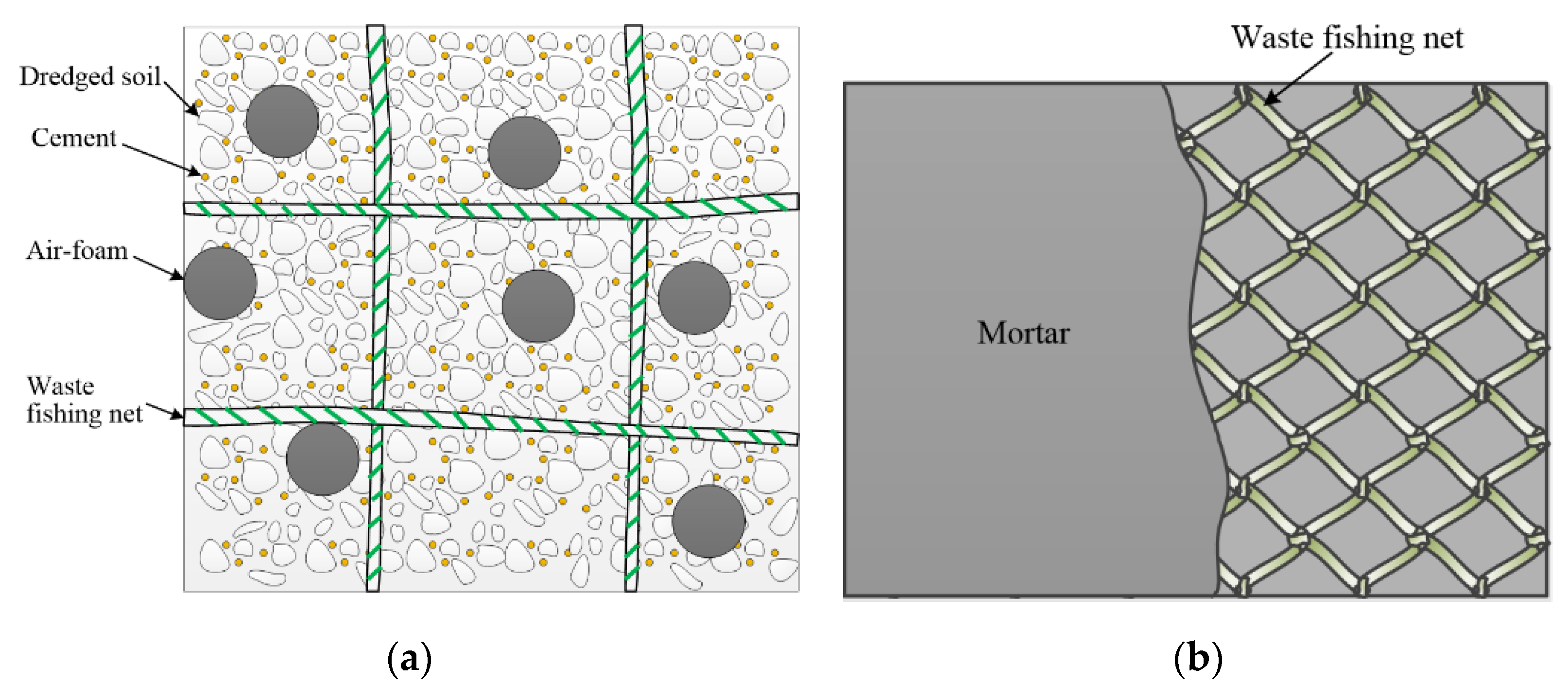







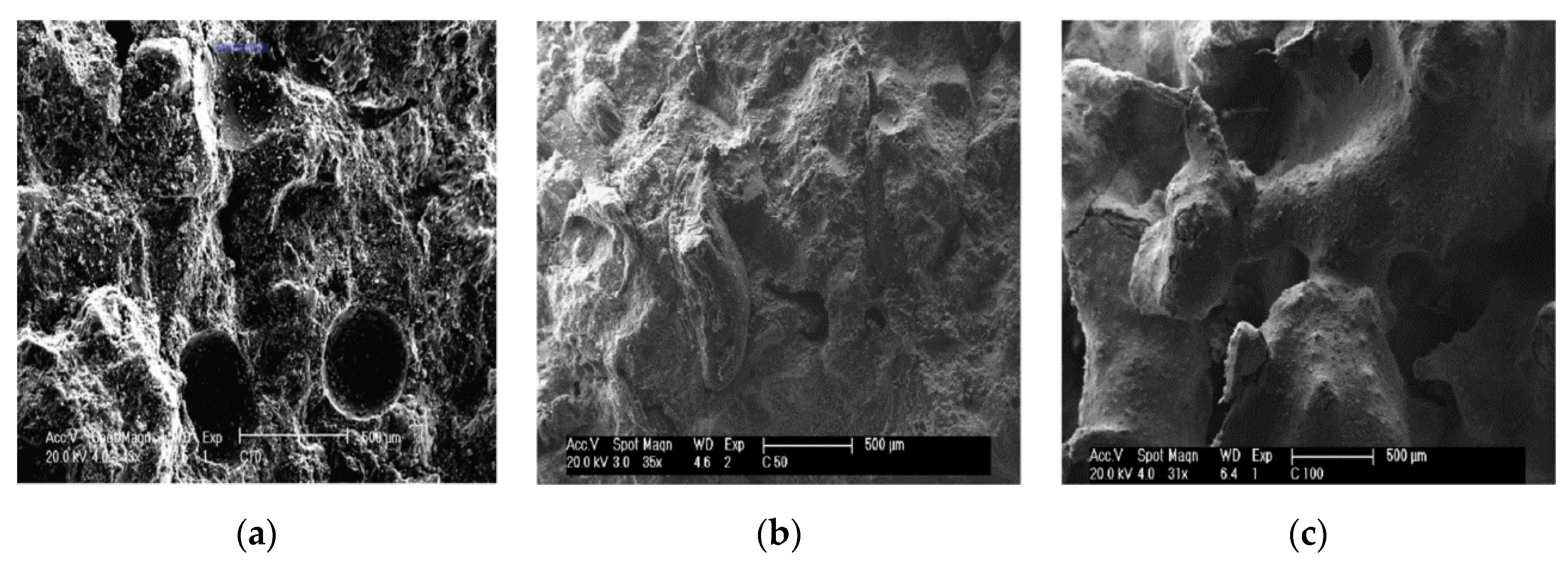

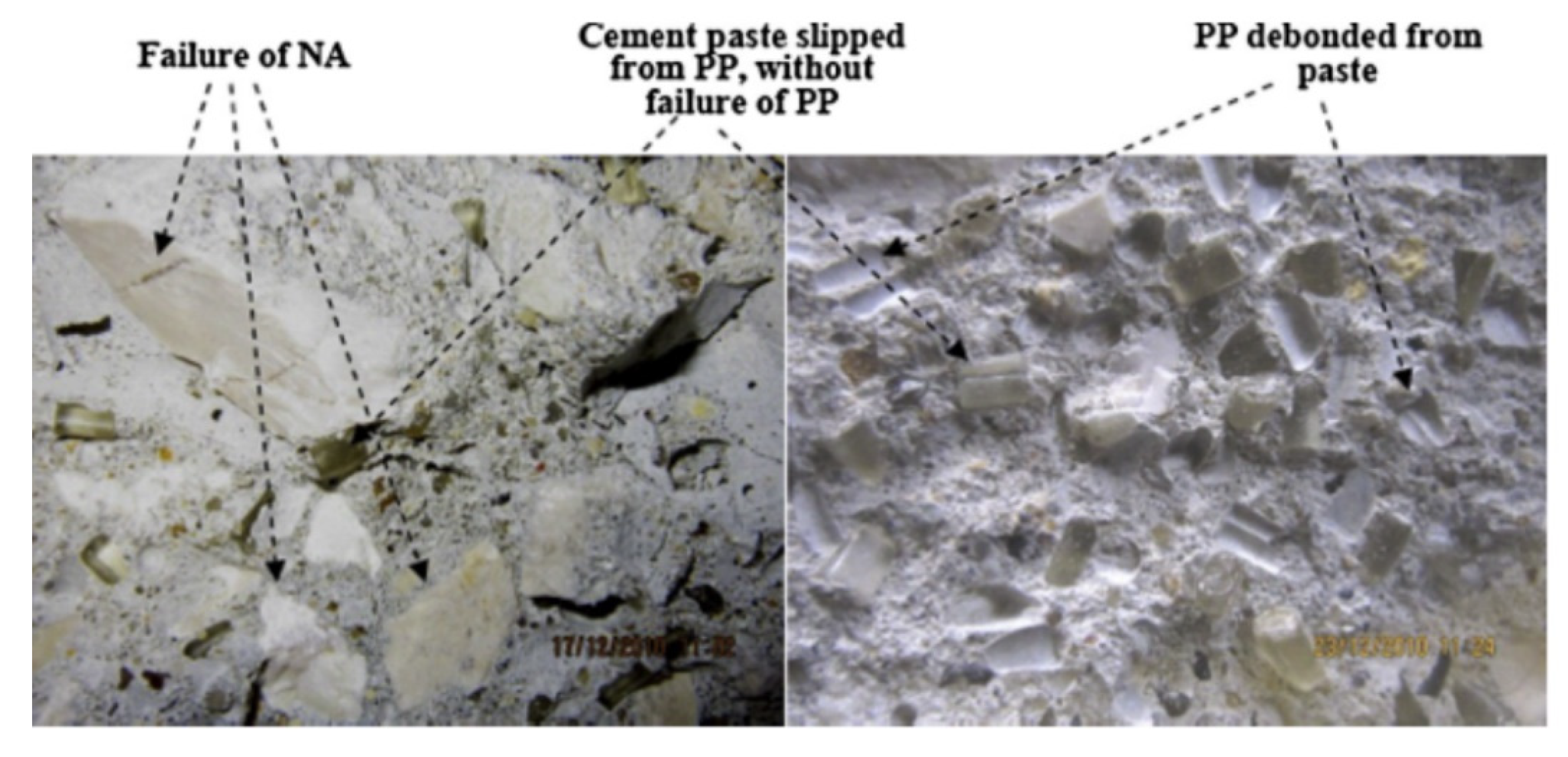


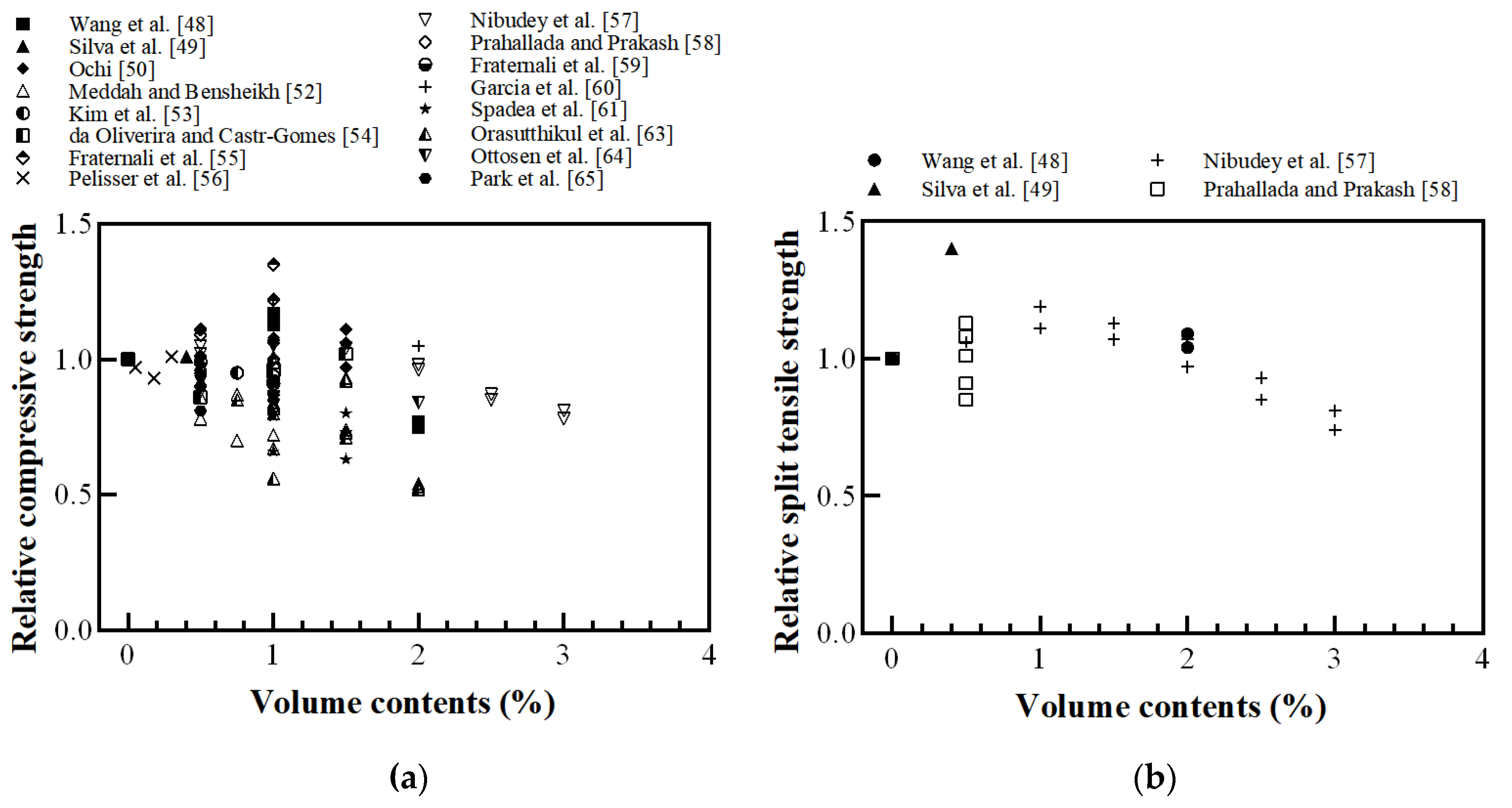

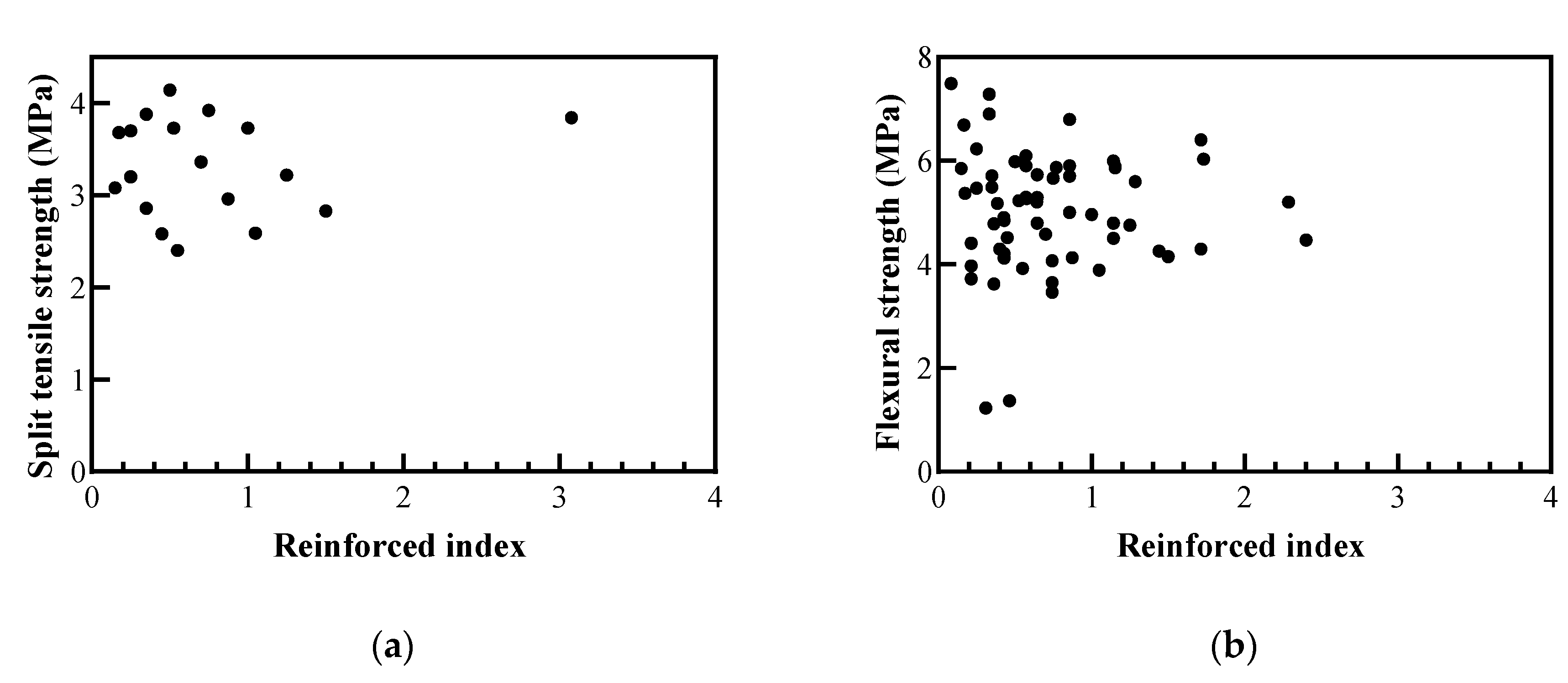
| No. | Reference | Type of Composites | Type of Plastic | Origin of Plastic Waste | Recycling Procedure | Target |
|---|---|---|---|---|---|---|
| 1 | Naik et al. [15] | Concrete | High-density polyethylene (HDPE) | Mixed | Shredding | Fine aggregate |
| 2 | Sabaa and Ravindrarajah [16] | Lightweight concrete | Expanded polystyrene (EPS) | - | Granular | Coarse aggregate |
| 3 | Choi et al. [17] | Concrete | Polyethylene terephthalate (PET) | Bottle | Grinding | Fine aggregate |
| 4 | Laukaitis et al. [18] | Non-load-bearing lightweight concrete | Polystyrene (PS) | Form | Crumbling | Fine aggregate |
| 5 | Batayneh et al. [19] | Concrete | Plastic | Mixed | Grinding | Fine aggregate |
| 6 | Marzouk et al. [20] | Mortar | PET | Bottle | Shredding | Fine aggregate |
| 7 | Panyakapo and Panyakapo [21] | Non-load-bearing lightweight concrete | Melamine | Melamine | Grinding | Fine aggregate |
| 8 | Ismail and Al-Hashmi [22] | Concrete | Mix plastic of 80% PET and 20% PS | - | Crushing | Fine aggregate |
| 9 | Kan and Demirboga [23] | Lightweight concrete | Modified EPS | EPS form | Thermal treatment | Coarse aggregate |
| 10 | Asokan et al. [24] | Concrete | Glass fiber-reinforced plastic (GFRP) | - | Grinding | Fine aggregate |
| 11 | Choi et al. [25] | Mortar and concrete | PET | Bottle | Mixed with river sand filler | Fine aggregate |
| 12 | Albano et al. [26] | Concrete | PET | Bottle | Grinding | Fine aggregate |
| 13 | Kou et al. [27] | Lightweight concrete | Polyvinyl chloride (PVC) | Pipe | Crushing | Fine aggregate |
| 14 | Remadnia et al. [28] | Mortar | PET | Bottle | Shredding | Fine aggregate |
| 15 | Akçaözoğlu et al. [29] | Lightweight concrete | PET | Bottle | Shredding | Fine aggregate |
| 16 | Asokan et al. [30] | Concrete | Glass fiber-reinforced plastic (GFRP) | - | Grinding | Fine aggregate |
| 17 | Lima et al. [31] | Lightweight concrete | Ethylene vinyl acetate (EVA) | Sheet | Crushing | Coarse aggregate |
| 18 | Frigione [32] | Concrete | PET | Bottle | Fine aggregate | |
| 19 | Fraj et al. [33] | Lightweight concrete | Polyurethane (PUR) | Form | Crushing | Coarse aggregate |
| 20 | Galvão et al. [34] | Concrete | PET and Low-density polyethylene (LDPE) | Bag, bottle | Crushing and Agglutinating | Fine aggregate |
| 21 | Ramadevi and Manju [35] | Concrete | PET | Bottle | Shredding | Fine aggregate |
| 22 | Ferreira et al. [36] | Concrete | PET | Bottle | Crushing and melting | Coarse and fine aggregate |
| 23 | Wang and Meyer [37] | Concrete | High-impact polystyrene (HIPS) | Electronics | Shredding | Fine aggregate |
| 24 | Silva et al. [38] | Concrete | PET | Waste | Crushing and melting | Fine aggregate |
| 25 | Herki et al. [39] | Lightweight concrete | EPS | - | - | Fine aggregate |
| 26 | Ge et al. [40] | Mortar | PET | Bottle | Shredding | Fine aggregate |
| 27 | Saikia and de Brito [41] | Concrete | PET | Bottle | Crushing and melting | Coarse and fine aggregate |
| 28 | Chaudhary et al. [42] | Concrete | LDPE | Bag | Shredding | Coarse and fine aggregate |
| 29 | Saikia and de Brito [43] | Concrete | PET | Bottle | Crushing and melting | Coarse and fine aggregate |
| 30 | Akçaözoğlu and Ulu [44] | Geo-polymer concrete | PET | Bottle | Crushing | Fine aggregate |
| 31 | Alqahtani et al. [45] | Lightweight concrete | Linear low-density polyethylene (LLDPE) | - | Mixed with red dune sand filler | Coarse aggregate |
| 32 | Badache et al. [46] | Mortar | HDPE | Waste pipe | Milling | Fine aggregate |
| 33 | Chen et al. [47] | Mortar | Polypropylene (PP) | Food packing | - | Fine aggregate |
| No. | Reference | Type of Composites | Type of Plastic | Origin of Plastic Waste | Recycling Procedure |
|---|---|---|---|---|---|
| 1 | Wang et al. [48] | Concrete | PP and Nylon 6 | Carpet | Grinding |
| 2 | Silva et al. [49] | Mortar | PET | Bottle | Extruding |
| 3 | Ochi [50] | Concrete | PET | Bottle | Extruding |
| 4 | Kim et al. [51] | Mortar | PET | Bottle | Melting and slitting |
| 5 | Meddah and Bensheikh [52] | Concrete | PP | Bag | Cutting |
| 6 | Kim et al. [53] | Concrete | PET | Bottle | Melting and slitting |
| 7 | da Oliveira and Castro-Gomes [54] | Mortar | PET | Bottle | Cutting |
| 8 | Fraternali et al. [55] | Concrete | PET | Bottle | Extruding |
| 9 | Pelisser et al. [56] | Concrete | PET | Bottle | Extruding |
| 10 | Nibudey et al. [57] | Concrete | PET | Bottle | Cutting |
| 11 | Prahallada and Prakash [58] | Concrete | Plastic | Pot | Cutting |
| 12 | Fraternali et al. [59] | Concrete | PET | Bottle | Extruding |
| 13 | García et al. [60] | Concrete | GFRP | - | Milling |
| 14 | Sharma et al. [61] | Concrete | PET | Bottle | Cutting |
| 15 | Spadea et al. [62] | Mortar | Nylon 6 | Waste fishing net | Cutting |
| 16 | Orasutthikul et al. [63] | Mortar | Nylon 6 | Waste fishing net | Cutting |
| 17 | Ottosen et al. [64] | Mortar | Nylon 6 | Waste fishing net | Cutting |
| 18 | Park et al. [65] | Mortar | HDPE | Waste fishing net | Cutting |
| No. | Reference | Geometry of Fiber | Diameter (mm) | Length (mm) | Aspect Ratio | Tensile Strength (MPa) |
|---|---|---|---|---|---|---|
| 1 | Wang et al. [48] | - | - | 3–25 | - | - |
| 2 | Silva et al. [49] | Straight | 0.026 | 20 | 769 | 323.5 |
| 3 | Ochi [50] | Straight | 0.7 | 30 | 43 | 450 |
| 4 | Kim et al. [51] | Straight | 0.5 × 1.0 | 50 | 63 | - |
| Crimped | 0.3 × 1.2 | 50 | 74 | - | ||
| Embossed | 0.2 × 1.3 | 50 | 87 | - | ||
| 5 | Meddah and Bensheikh [52] | Flat | - | 60 | - | - |
| 6 | Kim et al. [53] | Embossed | 0.2 × 1.3 | 50 | 87 | 420.7 |
| 7 | da Oliveira and Castro-Gomes [54] | Flat | 0.5 × 0.2 | 35 | 31 | - |
| 8 | Fraternali et al. [55] | Straight | 1.1 | 40 | 36 | 550 |
| Straight | 0.7 | 52 | 74 | 263.72 | ||
| Crimped | 0.7 | 52 | 74 | 274.29 | ||
| 9 | Pelisser et al. [56] | Multifilaments | 0.025 | 20 | 800 | - |
| 10 | Nibudey et al. [57] | Flat | 0.71 | 25 | 35 | - |
| 11 | Prahallada and Prakash [58] | - | - | - | 30–110 | - |
| 12 | Fraternali et al. [59] | Straight | 1.1 | 40 | 36 | 550 |
| Crimped | 0.7 | 52 | 74 | 274 | ||
| 13 | García et al. [60] | Fluff | - | - | - | - |
| 14 | Sharma et al. [61] | - | - | - | 15–60 | - |
| 15 | Spadea et al. [62] | Straight | 0.33 | 12.7 | 38 | 319 |
| Straight | 0.33 | 25.4 | 77 | 342 | ||
| Straight | 0.33 | 38.1 | 115 | 389 | ||
| 16 | Orasutthikul et al. [63] | Straight | 0.35 | 20 | 57 | 440 |
| Straight | 0.35 | 40 | 86 | 440 | ||
| Knotted | 0.35 | 40 | 114 | 440 | ||
| 17 | Ottosen et al. [64] | Twisted multifilaments | 1.2 | 20 | 17 | 260 |
| Twisted multifilaments | 1.2 | 40 | 33 | 260 | ||
| 18 | Park et al. [65] | Twisted multifilaments | 1 | 40 | 40 | 188 |
| Twisted multifilaments | 1.5 | 40 | 27 | 173 |
| No. | Reference | Type of Composites | Type of Plastic | Origin of Plastic Waste | Recycled Product |
|---|---|---|---|---|---|
| 1 | Kim et al. [71] | Lightweight soil | HDPE | Waste fishing net | Reinforcing textile |
| 2 | Mousa [72] | Mortar | HDPE | Waste fishing net | Reinforcing textile |
| 3 | Bertelsen et al. [73] | Concrete | - | Waste fishing net | Reinforcing bar |
| 4 | Sigvardsen [74] | Concrete | - | Waste fishing net | Reinforcing bar |
Publisher’s Note: MDPI stays neutral with regard to jurisdictional claims in published maps and institutional affiliations. |
© 2020 by the authors. Licensee MDPI, Basel, Switzerland. This article is an open access article distributed under the terms and conditions of the Creative Commons Attribution (CC BY) license (http://creativecommons.org/licenses/by/4.0/).
Share and Cite
Park, J.K.; Kim, M.O. Mechanical Properties of Cement-Based Materials with Recycled Plastic: A Review. Sustainability 2020, 12, 9060. https://doi.org/10.3390/su12219060
Park JK, Kim MO. Mechanical Properties of Cement-Based Materials with Recycled Plastic: A Review. Sustainability. 2020; 12(21):9060. https://doi.org/10.3390/su12219060
Chicago/Turabian StylePark, Jun Kil, and Min Ook Kim. 2020. "Mechanical Properties of Cement-Based Materials with Recycled Plastic: A Review" Sustainability 12, no. 21: 9060. https://doi.org/10.3390/su12219060
APA StylePark, J. K., & Kim, M. O. (2020). Mechanical Properties of Cement-Based Materials with Recycled Plastic: A Review. Sustainability, 12(21), 9060. https://doi.org/10.3390/su12219060






